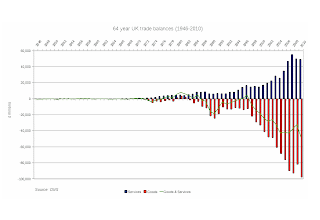House prices - a few unanswered questions
The Nationwide building society have been collecting data on house prices for some time and they have kindly discounted the average price they record each year by RPI, which they take to be a proxy for inflation.
Above is the chart from 1975 to the present, it is clear that around 2002 the 'real' price of an average house in the UK was at the peak experienced during the last boom (about £125,000 in 1989).
It was also in 2002 that the homeowner mortgage market reached saturation level and the number of residential mortgages began to decline from that peak of around 11m. The graph below shows this. The demand for homes at 2002 prices began to fall, represented by a fall in demand for homeowner mortgages from that time. This is a full 8 years ago, and the demand for homeowner mortgages has been falling every year.
This is expressed graphically another way - by showing the net annual demand for homeowner morgages as the graph below shows.
The fall in demand for homeowner mortgages at 2002 prices was disguised by a rapid increase in buy-to-let mortgages, and to a lesser extent second home mortgages, both of which not only made up the annual decline of homeowner mortgages, but actually increased the total book of mortgages, for several years. This trend stopped in 2007 when the fall in homeowner mortgage numbers outstripped the increase in these other mortgages.
So if the supply of homeowner mortgages reached a saturation point and the demand for houses at that price has dried up, why does the subsequent price of an average home increase exponentially from 2002-2008? A full 6 years. How can the price of an average home rise by around 70% (£125,000 to over £210,000) at a time when the supply of homes is greater than the demand at £125,000? This is a question I'll return to.
And if the demand for residential homes has peaked in 2002/3 why were we told over and over again that there was (and is) a shortage of homes?
Above is the chart from 1975 to the present, it is clear that around 2002 the 'real' price of an average house in the UK was at the peak experienced during the last boom (about £125,000 in 1989).
It was also in 2002 that the homeowner mortgage market reached saturation level and the number of residential mortgages began to decline from that peak of around 11m. The graph below shows this. The demand for homes at 2002 prices began to fall, represented by a fall in demand for homeowner mortgages from that time. This is a full 8 years ago, and the demand for homeowner mortgages has been falling every year.
This is expressed graphically another way - by showing the net annual demand for homeowner morgages as the graph below shows.
The fall in demand for homeowner mortgages at 2002 prices was disguised by a rapid increase in buy-to-let mortgages, and to a lesser extent second home mortgages, both of which not only made up the annual decline of homeowner mortgages, but actually increased the total book of mortgages, for several years. This trend stopped in 2007 when the fall in homeowner mortgage numbers outstripped the increase in these other mortgages.
So if the supply of homeowner mortgages reached a saturation point and the demand for houses at that price has dried up, why does the subsequent price of an average home increase exponentially from 2002-2008? A full 6 years. How can the price of an average home rise by around 70% (£125,000 to over £210,000) at a time when the supply of homes is greater than the demand at £125,000? This is a question I'll return to.
And if the demand for residential homes has peaked in 2002/3 why were we told over and over again that there was (and is) a shortage of homes?





Comments
Post a Comment